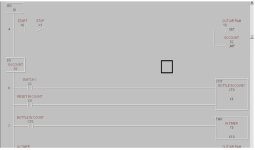John Deitz
Member
- Join Date
- Aug 2003
- Posts
- 13

Doesn't anyone else use stage programming?




John Deitz said:CT0 reset by contact C0

Raedawg said:Please anyone with some knowledge of putting together a ladder diagram with 12 inputs ( 8 standard 24 VDC and 4 fast 24 VDC.) and relay type outputs. It can be any type of machine. Email it to my address [email protected]. Please I need it by Monday, April 4th.
| X0 Y0
|---[ ]----------------------------[ SET ]
|
| X1 Y1
|---[ ]----------------------------[ SET ]
|
| X2 Y2
|---[ ]----------------------------[ SET ]
|
| X3 Y3
|---[ ]----------------------------[ SET ]
|
| X4 Y4
|---[ ]----------------------------[ SET ]
|
| X5 Y5
|---[ ]----------------------------[ SET ]
|
| X6 Y6
|---[ ]----------------------------[ SET ]
|
| X7 Y7
|---[ ]----------------------------[ SET ]
|
| X10 Y10
|---[ ]---------------------------[ SET ]
|
| X11 Y11
|---[ ]---------------------------[ SET ]
|
| X12 Y12
|---[ ]---------------------------[ SET ]
|
| X13 Y13
|---[ ]---------------------------[ SET ]
|
| X14 Y0 Y13
|---[ ]---------------------------[ RST ]
|
|-----------------------------------[ END ]
